Army Kicks Off Creative Reserve Pilot Program
For the first time ever, the U.S. Army is looking inward to collaborate with service member social media influencers and content creators to help build brand awareness. Still in its pilot phase, the Army Creative Reserve is a volunteer-based marketing initiative seeking to connect with people on a more personal level, indirectly aiding in retention and recruiting efforts.
Only a small number of the 23% eligible-to-serve public are inclined to do so, which is why Kris Saling and her team were tasked with looking for ways to expand the U.S. Army market for recruiting. Saling currently serves as the director of innovation for Army Talent Innovation within Manpower & Reserve Affairs at the U.S. Army. Saling and her team work with total force talent management across all three components and civilians. Part of their job is to find ways to invest and experiment for the best return on investment for the U.S. Army.
“We looked at how our marketing is being received and how our Army brand is retained,” Saling told SIGNAL Media in a call. “We were trying to figure out to better communicate the Army brand.”
“There are markets that just, no matter how much you pay for, you can’t get into, you’re just not reaching some people,” Saling stated. Some influencers within the military branch, however, are reaching those markets and beyond.
Therefore thus far, Saling explained, a very small team of content creators has been selected to either formally or informally participate in the Army Creative Reserve pilot program. All participants are volunteers and are therefore not receiving additional U.S. Army compensation for their work within the program.
"We're seeing people out on the commercial side getting $75K to $100K a video to do some of this stuff, but they're coming in and saying, 'Hey, I want to do this because I really love the Army.'"
The current small group of selected volunteers includes:
- Tyler Butterworth, also known as @butterworthdasyrup, currently has more than 2.4 million followers on Instagram and over 1.9 million followers on TikTok. Butterworth currently serves as the director of social media marketing for the National Guard Bureau.
- Platoon leader Austin von Letkemann, commonly referred to as MandatoryFunDay, has 412,000 followers on YouTube, over 1.2 million followers on Instagram and more than 17,000 followers on LinkedIn.
- Viva La Vargas, who serves as a platoon sergeant at Fort Hood, has over 23,000 Instagram followers, more than 84,000 followers on TikTok and over 23,000 followers on Facebook.
Of note, Saling stated that none of the selected content creators have service obligations at this time, and a couple of them are retirement eligible.
“A lot of these folks have people joining the Army because they see their videos,” Saling said, speaking to the guaranteed reach of organic influencer marketing. One thing the Army will not do is direct the creators to put anything on their personal platforms, she emphasized. “Their value as influencers is based on content being organic and their voice being authentic.”
Eventually, the goal is to create a network of content creators who can help amplify U.S. Army messaging. Additionally, the Creative Reserve team could help with event coverage. “We offer them the access, for the price of TDY [temporary duty travel], we get coverage that we wouldn’t get otherwise,” Saling said. The influencers would then be under a marketing plan to post through their personal accounts to potentially have post collaborations through the social media platforms.
Sharing Saling's announcement on LinkedIn, Butterworth echoed her statements, adding that he has "never understood why we pay people outside of our organization to tell Army stories," he wrote in a post. "We have stories, and we are the stories," he stated.
While this effort is unlikely to directly impact recruitment rates, Saling said she believes the increase in brand awareness and storytelling through personal accounts will encourage more people to join the force.
“I think improved recruiting will be a side effect, but the biggest thing is getting people out there, soldiers telling their stories, building online communities the way we used to, building more in person communities when we had more distributed bases and more people knew somebody who served,” Saling stated. “People are more likely to join if they know someone who serves.”





Comments